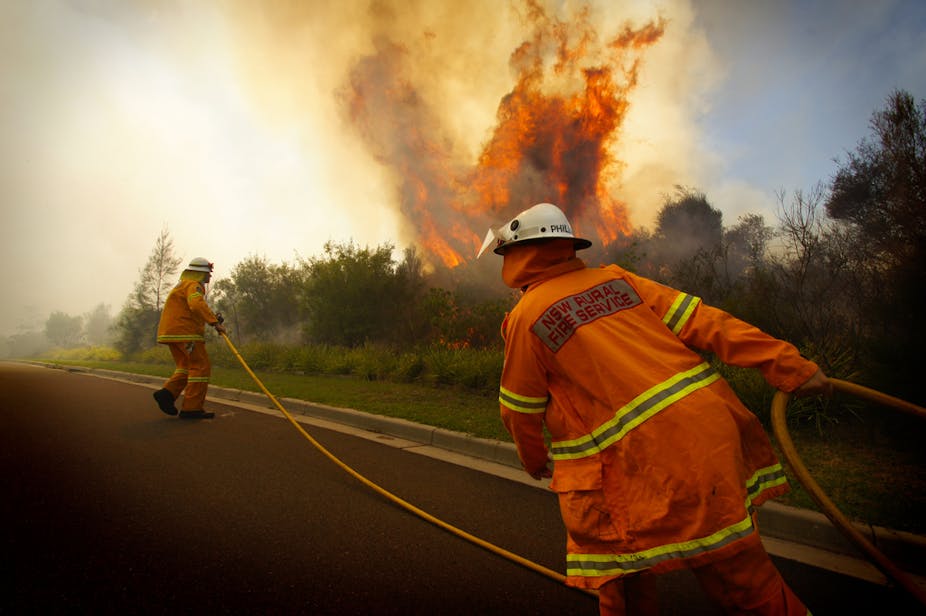The Greater Sydney region contains the largest urban centre in Australia, and is also, thanks to its landscape and forests, prone to intense bushfires. Tens of thousands of properties and businesses are on the front line.
Since last Thursday we’ve seen hundreds of homes destroyed across New South Wales. When bushfires are a fact of life, how do we protect properties and people?
There are two methods, which we can think of as the “sword” and the “shield”. The “sword” is offensive: prescribed burning throughout the landscape. The “shield” is targeted, defensive hazard reduction close to properties and infrastructure.
So which is better?
The key question should be “which strategy gives us the most risk reduction for cost?” Until recently, we didn’t know the answer. But newly published and forthcoming research in the Sydney region has given us the first comprehensive information on cost and effectiveness.
Hazard reduction in the bush
The principal method of hazard reduction is the pre-emptive use of prescribed fire throughout a fire-prone landscape. Fires are typically lit in cool weather conditions to reduce the mass of surface litter in the forests and shrublands of the region.
We typically use clearing and mechanical treatment in a more restricted manner, next to urban developments and on the margins of roads and rails.
Historical and computer simulation analyses show that this approach is moderately cost-effective.
To halve the risk to people and property using prescribed fire would mean treating about 10% of the landscape each year. This is an order of magnitude above current levels of prescribed burning, and a similar increase in funding would be required.
Based on analysis of current costs, such an increase is unlikely, either in the Greater Sydney region, or over the broader area of fire-prone NSW.
Hazard reduction around property
The alternative is focusing efforts around property and infrastructure - the “shield” of hazard reduction. A range of research shows that it is the fuel conditions in forests close to property, the distance of property from forest edges, and the nature of gardens that have a very strong influence on risk or loss during fires.
The extent of forest within a kilometre of property, as well as the distance to the edge of the forest are critical for survival. Houses close to (e.g. < 50 m) uncleared expanses of forest are highly vulnerable to fire in severe weather. The nature of garden vegetation is also critical up to 40 m around houses.
A range of hazard reduction methods - prescribed burning, thinning, clearing, and garden design and maintenance - targeted in this critical zone near developments can therefore have a powerful effect on reducing bushfire risk.
This can be more cost effective than prescribed burning throughout a landscape. Post-fire analyses and modelling show that, for example, using prescribed fire next to properties may be up to five times more effective than treatments more distant in the landscape.
The weight of evidence therefore shows that a package of hazard reduction measures is needed to form an in-depth defensive shield around urban development in the region. The strategy is backed up further by the fact that most fires start relatively close to urban development and roads in the region.
We have to live with the risk
The current hazard reduction policy in NSW reflects these insights. In coming years we will see increased hazard reduction near homes. The current fires should provide further motivation to increase this defensive shield. There are going to be difficult decisions to confront, such as clearing vegetation close to existing developments. This may change the character and appeal of bushland areas, which will be controversial for residents.
But these efforts will never completely remove the risk. No financially feasible hazard reduction program will minimise risk to people and property. Very high levels of risk will remain even when these ambitious and carefully-planned programs are implemented.
So we need complementary action to better prepare property and people, and better planning and development regulations.
The prospect of warmer and drier climate in the regions strengthens the need for better hazard reduction. Modelling shows that climate change could completely negate increases in hazard reduction, unless it is targeted where it is needed.
There will always be a need for fuel reduction across the broader landscape to achieve other goals, such as conserving ecosystem services and biodiversity. But such measures need to be built on the bedrock of fuel and hazard reduction around properties. Climate change will only make these actions more pressing.
For further reading, see our bushfire coverage here.

